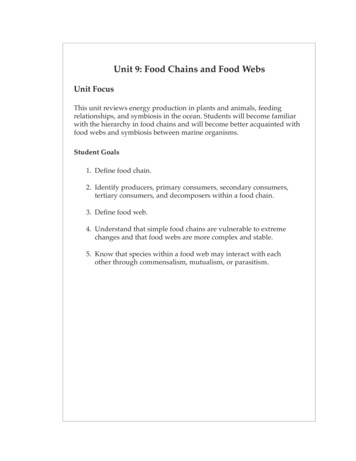
Transcription
HIGHLIGHTS OF PRESCRIBING INFORMATIONThese highlights do not include all the information needed to useDULERA safely and effectively. See full prescribing information forDULERA.DULERA 100 mcg/5 mcg (mometasone furoate 100 mcg and formoterolfumarate dihydrate 5 mcg) Inhalation AerosolDULERA 200 mcg/5 mcg (mometasone furoate 200 mcg and formoterolfumarate dihydrate 5 mcg) Inhalation AerosolFOR ORAL INHALATIONInitial U.S. Approval: 2010 WARNING: ASTHMA-RELATED DEATHSee full prescribing information for complete boxed warning.Long-acting beta2-adrenergic agonists (LABA), such as formoterol,one of the active ingredients in DULERA, increase the risk ofasthma-related death. Data from a large placebo-controlled U.S.study that compared the safety of another LABA (salmeterol) orplacebo added to usual asthma therapy showed an increase inasthma-related deaths in patients receiving salmeterol. This findingwith salmeterol is considered a class effect of the LABA, includingformoterol. Currently available data are inadequate to determinewhether concurrent use of inhaled corticosteroids or other long-termasthma control drugs mitigates the increased risk of asthma-relateddeath from LABA. Available data from controlled clinical trialssuggest that LABA increase the risk of asthma-relatedhospitalization in pediatric and adolescent patients.When treating patients with asthma, prescribe DULERA only forpatients with asthma not adequately controlled on a long-termasthma control medication, such as an inhaled corticosteroid orwhose disease severity clearly warrants initiation of treatment withboth an inhaled corticosteroid and LABA. Once asthma control isachieved and maintained, assess the patient at regular intervals andstep down therapy (e.g., discontinue DULERA) if possible withoutloss of asthma control, and maintain the patient on a long-termasthma control medication, such as an inhaled corticosteroid. Do notuse DULERA for patients whose asthma is adequately controlled onlow or medium dose inhaled corticosteroids. (1.1, 5.1)---------------------------RECENT MAJOR CHANGES -------------------------- Warnings and Precautions, Coexisting Conditions (5.15)07/2013--------------------------- INDICATIONS AND USAGE--------------------------- DULERA is a combination product containing a corticosteroid and a longacting beta2-adrenergic agonist indicated for: Treatment of asthma in patients 12 years of age and older. (1.1)Important limitations: Not indicated for the relief of acute bronchospasm. (1.1)-----------------------DOSAGE AND ADMINISTRATION ---------------------- For oral inhalation only.Treatment of asthma in patients 12 years: 2 inhalations twice daily ofDULERA 100 mcg/5 mcg or 200 mcg/5 mcg. Starting dosage is based onprior asthma therapy. (2.2)--------------------- DOSAGE FORMS AND STRENGTHS--------------------- Inhalation aerosol containing a combination of mometasone furoate (100 or200 mcg) and formoterol fumarate dihydrate (5 mcg) per actuation. (3) Localized infections: Candida albicans infection of the mouth and throatmay occur. Monitor patients periodically for signs of adverse effects onthe oral cavity. Advise patients to rinse the mouth following inhalation.(5.4)Immunosuppression: Potential worsening of existing tuberculosis, fungal,bacterial, viral, or parasitic infection; or ocular herpes simplex infections.More serious or even fatal course of chickenpox or measles can occur insusceptible patients. Use with caution in patients with these infectionsbecause of the potential for worsening of these infections. (5.5)Transferring patients from systemic corticosteroids: Risk of impairedadrenal function when transferring from oral steroids. Taper patientsslowly from systemic corticosteroids if transferring to DULERA. (5.6)Hypercorticism and adrenal suppression: May occur with very highdosages or at the regular dosage in susceptible individuals. If suchchanges occur, discontinue DULERA slowly. (5.7)Strong cytochrome P450 3A4 inhibitors (e.g., ritonavir): Risk ofincreased systemic corticosteroid effects. Exercise caution when usedwith DULERA. (5.8)Paradoxical bronchospasm: Discontinue DULERA and institutealternative therapy if paradoxical bronchospasm occurs. (5.9)Patients with cardiovascular disorders: Use with caution because of beta adrenergic stimulation. (5.11)Decreases in bone mineral density: Monitor patients with major riskfactors for decreased bone mineral content. (5.12)Effects on growth: Monitor growth of pediatric patients. (5.13)Glaucoma and cataracts: Monitor patients with change in vision or with ahistory of increased intraocular pressure, glaucoma, and/or cataractsclosely. (5.14)Coexisting conditions: Use with caution in patients with aneurysm,pheochromocytoma, convulsive disorders, thyrotoxicosis, diabetesmellitus, and ketoacidosis. (5.15)Hypokalemia and hyperglycemia: Be alert to hypokalemia andhyperglycemia. (5.16)------------------------------ ADVERSE REACTIONS ----------------------------- Most common adverse reactions (reported in 3% of patients) included: Nasopharyngitis, sinusitis and headache. (6.1)To report SUSPECTED ADVERSE REACTIONS, contact Merck Sharp& Dohme Corp., a subsidiary of Merck & Co., Inc., at 1-877-888-4231 orFDA at 1-800-FDA-1088 or - DRUG INTERACTIONS------------------------------ Strong cytochrome P450 3A4 inhibitors (e.g., ritonavir): Use withcaution. May cause increased systemic corticosteroid effects. (7.1) Adrenergic agents: Use with caution. Additional adrenergic drugs maypotentiate sympathetic effects. (7.2) Xanthine derivatives and diuretics: Use with caution. May potentiateECG changes and/or hypokalemia. (7.3, 7.4) MAO inhibitors, tricyclic antidepressants, macrolides, and drugs thatprolong QTc interval: Use with extreme caution. May potentiate effect onthe cardiovascular system. (7.5) Beta-blockers: Use with caution and only when medically necessary.May decrease effectiveness and produce severe bronchospasm. (7.6) Halogenated hydrocarbons: There is an elevated risk of arrhythmias inpatients receiving concomitant anesthesia with halogenatedhydrocarbons. (7.7)------------------------------ CONTRAINDICATIONS ----------------------------- Primary treatment of status asthmaticus or acute episodes of asthmarequiring intensive measures. (4.1) Hypersensitivity to any of the ingredients of DULERA. (4.2)----------------------- USE IN SPECIFIC POPULATIONS ---------------------- Hepatic impairment: Monitor patients for signs of increased drugexposure. (8.6)----------------------- WARNINGS AND PRECAUTIONS----------------------- Asthma-related death: Long-acting beta2-adrenergic agonists increase therisk. Prescribe only for recommended patient populations. (5.1) Deterioration of disease and acute episodes: Do not initiate in acutelydeteriorating asthma or to treat acute symptoms. (5.2) Use with additional long-acting beta2-agonist: Do not use in combinationbecause of risk of overdose. (5.3)See 17 for PATIENT COUNSELING INFORMATION and MedicationGuide.FULL PRESCRIBING INFORMATION: CONTENTS*2WARNING: ASTHMA-RELATED DEATHINDICATIONS AND USAGE11.1 Treatment of Asthma34Reference ID: 3361125Revised: XX/XXXX08/2013DOSAGE AND ADMINISTRATION2.1 General2.2 DosingDOSAGE FORMS AND STRENGTHSCONTRAINDICATIONS
5674.1 Status Asthmaticus4.2 HypersensitivityWARNINGS AND PRECAUTIONS5.1 Asthma-Related Death5.2 Deterioration of Disease and Acute Episodes5.3 Excessive Use of DULERA and Use with Other Long-ActingBeta2-Agonists5.4 Local Effects5.5 Immunosuppression5.6 Transferring Patients from Systemic Corticosteroid Therapy5.7 Hypercorticism and Adrenal Suppression5.8 Drug Interactions with Strong Cytochrome P450 3A4 Inhibitors5.9 Paradoxical Bronchospasm and Upper Airway Symptoms5.10 Immediate Hypersensitivity Reactions5.11 Cardiovascular and Central Nervous System Effects5.12 Reduction in Bone Mineral Density5.13 Effect on Growth5.14 Glaucoma and Cataracts5.15 Coexisting Conditions5.16 Hypokalemia and HyperglycemiaADVERSE REACTIONS6.1 Clinical Trials Experience6.2 Postmarketing ExperienceDRUG INTERACTIONS7.1 Inhibitors of Cytochrome P450 3A47.2 Adrenergic agents7.3 Xanthine derivatives7.4 Diuretics7.5 Monoamine oxidase inhibitors, tricyclic antidepressants, anddrugs known to prolong the QTc interval7.6 Beta-adrenergic receptor antagonists7.7 Halogenated Hydrocarbons810111213141617USE IN SPECIFIC POPULATIONS8.1 Pregnancy8.2 Labor and Delivery8.3 Nursing Mothers8.4 Pediatric Use8.5 Geriatric Use8.6 Hepatic ImpairmentOVERDOSAGE10.1 Signs and Symptoms10.2 TreatmentDESCRIPTIONCLINICAL PHARMACOLOGY12.1 Mechanism of Action12.2 Pharmacodynamics12.3 PharmacokineticsNONCLINICAL TOXICOLOGY13.1 Carcinogenesis, Mutagenesis, Impairment of Fertility13.2 Animal Toxicology and/or PharmacologyCLINICAL STUDIES14.1 AsthmaHOW SUPPLIED/STORAGE AND HANDLING16.1 How Supplied16.2 Storage and HandlingPATIENT COUNSELING INFORMATION17.1 Asthma-Related Death17.2 Not for Acute Symptoms17.3 Do Not Use Additional Long-Acting Beta2-Agonists17.4 Risks Associated With Corticosteroid Therapy17.5 Risks Associated With Beta-Agonist Therapy*Sections or subsections omitted from the full prescribing information are notlisted.FULL PRESCRIBING INFORMATIONWARNING: ASTHMA-RELATED DEATHLong-acting beta2-adrenergic agonists (LABA), such as formoterol, one of the active ingredients in DULERA, increase the riskof asthma-related death. Data from a large placebo-controlled U.S. study that compared the safety of another long-actingbeta2-adrenergic agonist (salmeterol) or placebo added to usual asthma therapy showed an increase in asthma-related deathsin patients receiving salmeterol. This finding with salmeterol is considered a class effect of the LABA, including formoterol.Currently available data are inadequate to determine whether concurrent use of inhaled corticosteroids or other long-termasthma control drugs mitigates the increased risk of asthma-related death from LABA. Available data from controlled clinicaltrials suggest that LABA increase the risk of asthma-related hospitalization in pediatric and adolescent patients. Therefore,when treating patients with asthma, DULERA should only be used for patients not adequately controlled on a long-termasthma control medication, such as an inhaled corticosteroid or whose disease severity clearly warrants initiation of treatmentwith both an inhaled corticosteroid and LABA. Once asthma control is achieved and maintained, assess the patient at regularintervals and step down therapy (e.g., discontinue DULERA) if possible without loss of asthma control, and maintain thepatient on a long-term asthma control medication, such as an inhaled corticosteroid. Do not use DULERA for patients whoseasthma is adequately controlled on low or medium dose inhaled corticosteroids. [See Warnings and Precautions (5.1).]1INDICATIONS AND USAGE1.1 Treatment of AsthmaDULERA is indicated for the treatment of asthma in patients 12 years of age and older.Long-acting beta2-adrenergic agonists, such as formoterol, one of the active ingredients in DULERA, increase the risk of asthmarelated death. Available data from controlled clinical trials suggest that LABA increase the risk of asthma-related hospitalization inpediatric and adolescent patients [see Warnings and Precautions (5.1)]. Therefore, when treating patients with asthma, DULERAshould only be used for patients not adequately controlled on a long-term asthma control medication, such as an inhaled corticosteroidor whose disease severity clearly warrants initiation of treatment with both an inhaled corticosteroid and LABA. Once asthma controlis achieved and maintained, assess the patient at regular intervals and step down therapy (e.g., discontinue DULERA) if possiblewithout loss of asthma control, and maintain the patient on a long-term asthma control medication, such as an inhaled corticosteroid.Do not use DULERA for patients whose asthma is adequately controlled on low or medium dose inhaled corticosteroids.Important Limitation of Use DULERA is NOT indicated for the relief of acute bronchospasm.418131-MFF-AO-USPI.18Reference ID: 33611252
2DOSAGE AND ADMINISTRATION2.1 GeneralDULERA should be administered only by the orally inhaled route (see Instructions for Using DULERA in the Medication Guide).After each dose, the patient should be advised to rinse his/her mouth with water without swallowing.The cap from the mouthpiece of the actuator should be removed before using DULERA.DULERA should be primed before using for the first time by releasing 4 test sprays into the air, away from the face, shaking wellbefore each spray. In cases where the inhaler has not been used for more than 5 days, prime the inhaler again by releasing 4 test spraysinto the air, away from the face, shaking well before each spray.The DULERA canister should only be used with the DULERA actuator. The DULERA actuator should not be used with any otherinhalation drug product. Actuators from other products should not be used with the DULERA canister.2.2 DosingDULERA should be administered as two inhalations twice daily every day (morning and evening) by the orally inhaled route.Shake well prior to each inhalation.The recommended starting dosages for DULERA treatment are based on prior asthma therapy.Table 1: Recommended Dosages for DULERARecommended DoseMaximum Recommended DailyDoseInhaled medium doseDULERA 100 mcg/5 mcg, 2400 mcg/20 mcgcorticosteroidsinhalations twice dailyInhaled high dose corticosteroidsDULERA 200 mcg/5 mcg, 2800 mcg/20 mcginhalations twice dailyPrevious TherapyThe maximum daily recommended dose is two inhalations of DULERA 200 mcg/5 mcg twice daily. Do not use more than twoinhalations twice daily of the prescribed strength of DULERA as some patients are more likely to experience adverse effects withhigher doses of formoterol. If symptoms arise between doses, an inhaled short-acting beta2-agonist should be taken for immediaterelief.If a previously effective dosage regimen of DULERA fails to provide adequate control of asthma, the therapeutic regimen should bere-evaluated and additional therapeutic options, e.g., replacing the current strength of DULERA with a higher strength, addingadditional inhaled corticosteroid, or initiating oral corticosteroids, should be considered.The maximum benefit may not be achieved for 1 week or longer after beginning treatment. Individual patients may experience avariable time to onset and degree of symptom relief. For patients 12 years of age who do not respond adequately after 2 weeks oftherapy, higher strength may provide additional asthma control.3DOSAGE FORMS AND STRENGTHSDULERA is a pressurized metered dose inhaler that is available in 2 strengths.DULERA 100 mcg/5 mcg delivers 100 mcg of mometasone furoate and 5 mcg of formoterol fumarate dihydrate per actuation.DULERA 200 mcg/5 mcg delivers 200 mcg of mometasone furoate and 5 mcg of formoterol fumarate dihydrate per actuation.4CONTRAINDICATIONS4.1 Status AsthmaticusDULERA is contraindicated in the primary treatment of status asthmaticus or other acute episodes of asthma where intensivemeasures are required.4.2 HypersensitivityDULERA is contraindicated in patients with known hypersensitivity to mometasone furoate, formoterol fumarate, or any of theingredients in DULERA [see Warnings and Precautions (5.10)].418131-MFF-AO-USPI.18Reference ID: 33611253
5WARNINGS AND PRECAUTIONS5.1 Asthma-Related DeathLong-acting beta2-adrenergic agonists, such as formoterol, one of the active ingredients in DULERA, increase the risk ofasthma-related death. Currently available data are inadequate to determine whether concurrent use of inhaled corticosteroidsor other long-term asthma control drugs mitigates the increased risk of asthma-related death from LABA. Available datafrom controlled clinical trials suggest that LABA increase the risk of asthma-related hospitalization in pediatric andadolescent patients. Therefore, when treating patients with asthma, physicians should only prescribe DULERA for patientswith asthma not adequately controlled on a long-term asthma control medication, such as an inhaled corticosteroid or whosedisease severity clearly warrants initiation of treatment with both an inhaled corticosteroid and LABA. Once asthma control isachieved and maintained, assess the patient at regular intervals and step down therapy (e.g., discontinue DULERA) if possiblewithout loss of asthma control, and maintain the patient on a long-term asthma control medication, such as an inhaledcorticosteroid. Do not use DULERA for patients whose asthma is adequately controlled on low or medium dose inhaledcorticosteroids.A 28-week, placebo-controlled US study comparing the safety of salmeterol with placebo, each added to usual asthma therapy,showed an increase in asthma-related deaths in patients receiving salmeterol (13/13,176 in patients treated with salmeterol vs.3/13,179 in patients treated with placebo; RR 4.37, 95% CI 1.25, 15.34). This finding with salmeterol is considered a class effect ofthe LABAs, including formoterol, one of the active ingredients in DULERA. No study adequate to determine whether the rate ofasthma-related death is increased with DULERA has been conducted.Clinical studies with formoterol suggested a higher incidence of serious asthma exacerbations in patients who received formoterolfumarate than in those who received placebo. The sizes of these studies were not adequate to precisely quantify the differences inserious asthma exacerbation rates between treatment groups.5.2 Deterioration of Disease and Acute EpisodesDULERA should not be initiated in patients during rapidly deteriorating or potentially life-threatening episodes of asthma. DULERAhas not been studied in patients with acutely deteriorating asthma. The initiation of DULERA in this setting is not appropriate.Increasing use of inhaled, short-acting beta2-agonists is a marker of deteriorating asthma. In this situation, the patient requiresimmediate re-evaluation with reassessment of the treatment regimen, giving special consideration to the possible need for replacingthe current strength of DULERA with a higher strength, adding additional inhaled corticosteroid, or initiating systemic corticosteroids.Patients should not use more than 2 inhalations twice daily (morning and evening) of DULERA.DULERA is not indicated for the relief of acute symptoms, i.e., as rescue therapy for the treatment of acute episodes of bronchospasm.An inhaled, short-acting beta2-agonist, not DULERA, should be used to relieve acute symptoms such as shortness of breath. Whenprescribing DULERA, the physician must also provide the patient with an inhaled, short-acting beta2-agonist (e.g., albuterol) fortreatment of acute symptoms, despite regular twice-daily (morning and evening) use of DULERA.When beginning treatment with DULERA, patients who have been taking oral or inhaled, short-acting beta2-agonists on a regularbasis (e.g., 4 times a day) should be instructed to discontinue the regular use of these drugs.5.3 Excessive Use of DULERA and Use with Other Long-Acting Beta2-AgonistsAs with other inhaled drugs containing beta2-adrenergic agents, DULERA should not be used more often than recommended, at higherdoses than recommended, or in conjunction with other medications containing long-acting beta2-agonists, as an overdose may result.Clinically significant cardiovascular effects and fatalities have been reported in association with excessive use of inhaledsympathomimetic drugs. Patients using DULERA should not use an additional long-acting beta2-agonist (e.g., salmeterol, formoterolfumarate, arformoterol tartrate) for any reason, including prevention of exercise-induced bronchospasm (EIB) or the treatment ofasthma.5.4 Local EffectsIn clinical trials, the development of localized infections of the mouth and pharynx with Candida albicans have occurred in patientstreated with DULERA. If oropharyngeal candidiasis develops, it should be treated with appropriate local or systemic (i.e., oral)antifungal therapy while remaining on treatment with DULERA therapy, but at times therapy with DULERA may need to beinterrupted. Advise patients to rinse the mouth after inhalation of DULERA.5.5 ImmunosuppressionPersons who are using drugs that suppress the immune system are more susceptible to infections than healthy individuals.Chickenpox and measles, for example, can have a more serious or even fatal course in susceptible children or adults usingcorticosteroids. In such children or adults who have not had these diseases or who are not properly immunized, particular care should418131-MFF-AO-USPI.18Reference ID: 33611254
be taken to avoid exposure. How the dose, route, and duration of corticosteroid administration affect the risk of developing adisseminated infection is not known. The contribution of the underlying disease and/or prior corticosteroid treatment to the risk is alsonot known. If exposed to chickenpox, prophylaxis with varicella zoster immune globulin (VZIG) or pooled intravenousimmunoglobulin (IVIG) may be indicated. If exposed to measles, prophylaxis with pooled intramuscular immunoglobulin (IG) may beindicated. (See the respective package inserts for complete VZIG and IG prescribing information.) If chickenpox develops, treatmentwith antiviral agents may be considered.DULERA should be used with caution, if at all, in patients with active or quiescent tuberculosis infection of the respiratory tract,untreated systemic fungal, bacterial, viral, or parasitic infections; or ocular herpes simplex.5.6 Transferring Patients from Systemic Corticosteroid TherapyParticular care is needed for patients who are transferred from systemically active corticosteroids to DULERA because deaths due toadrenal insufficiency have occurred in asthmatic patients during and after transfer from systemic corticosteroids to less systemicallyavailable inhaled corticosteroids. After withdrawal from systemic corticosteroids, a number of months are required for recovery ofhypothalamic-pituitary-adrenal (HPA) function.Patients who have been previously maintained on 20 mg or more per day of prednisone (or its equivalent) may be most susceptible,particularly when their systemic corticosteroids have been almost completely withdrawn. During this period of HPA suppression,patients may exhibit signs and symptoms of adrenal insufficiency when exposed to trauma, surgery, or infection (particularlygastroenteritis) or other conditions associated with severe electrolyte loss. Although DULERA may improve control of asthmasymptoms during these episodes, in recommended doses it supplies less than normal physiological amounts of corticosteroidsystemically and does NOT provide the mineralocorticoid activity necessary for coping with these emergencies.During periods of stress or severe asthma attack, patients who have been withdrawn from systemic corticosteroids should be instructedto resume oral corticosteroids (in large doses) immediately and to contact their physicians for further instruction. These patientsshould also be instructed to carry a medical identification card indicating that they may need supplementary systemic corticosteroidsduring periods of stress or severe asthma attack.Patients requiring systemic corticosteroids should be weaned slowly from systemic corticosteroid use after transferring to DULERA.Lung function (FEV1 or PEF), beta-agonist use, and asthma symptoms should be carefully monitored during withdrawal of systemiccorticosteroids. In addition to monitoring asthma signs and symptoms, patients should be observed for signs and symptoms of adrenalinsufficiency such as fatigue, lassitude, weakness, nausea and vomiting, and hypotension.Transfer of patients from systemic corticosteroid therapy to DULERA may unmask allergic conditions previously suppressed by thesystemic corticosteroid therapy, e.g., rhinitis, conjunctivitis, eczema, arthritis, and eosinophilic conditions.During withdrawal from oral corticosteroids, some patients may experience symptoms of systemically active corticosteroidwithdrawal, e.g., joint and/or muscular pain, lassitude, and depression, despite maintenance or even improvement of respiratoryfunction.5.7 Hypercorticism and Adrenal SuppressionMometasone furoate, a component of DULERA, will often help control asthma symptoms with less suppression of HPA function thantherapeutically equivalent oral doses of prednisone. Since mometasone furoate is absorbed into the circulation and can be systemicallyactive at higher doses, the beneficial effects of DULERA in minimizing HPA dysfunction may be expected only when recommendeddosages are not exceeded and individual patients are titrated to the lowest effective dose.Because of the possibility of systemic absorption of inhaled corticosteroids, patients treated with DULERA should be observedcarefully for any evidence of systemic corticosteroid effects. Particular care should be taken in observing patients postoperatively orduring periods of stress for evidence of inadequate adrenal response.It is possible that systemic corticosteroid effects such as hypercorticism and adrenal suppression (including adrenal crisis) may appearin a small number of patients, particularly when mometasone furoate is administered at higher than recommended doses overprolonged periods of time. If such effects occur, the dosage of DULERA should be reduced slowly, consistent with acceptedprocedures for reducing systemic corticosteroids and for management of asthma symptoms.5.8 Drug Interactions with Strong Cytochrome P450 3A4 InhibitorsCaution should be exercised when considering the coadministration of DULERA with ketoconazole, and other known strong CYP3A4inhibitors (e.g., ritonavir, atazanavir, clarithromycin, indinavir, itraconazole, nefazodone, nelfinavir, saquinavir, telithromycin)because adverse effects related to increased systemic exposure to mometasone furoate may occur [see Drug Interactions (7.1) andClinical Pharmacology (12.3)].418131-MFF-AO-USPI.18Reference ID: 33611255
5.9 Paradoxical Bronchospasm and Upper Airway SymptomsDULERA may produce inhalation induced bronchospasm with an immediate increase in wheezing after dosing that may be lifethreatening. If inhalation induced bronchospasm occurs, it should be treated immediately with an inhaled, short-acting bronchodilator.DULERA should be discontinued immediately and alternative therapy instituted.5.10 Immediate Hypersensitivity ReactionsImmediate hypersensitivity reactions may occur after administration of DULERA, as demonstrated by cases of urticaria, flushing,allergic dermatitis, and bronchospasm.5.11 Cardiovascular and Central Nervous System EffectsExcessive beta-adrenergic stimulation has been associated with seizures, angina, hypertension or hypotension, tachycardia with ratesup to 200 beats/min, arrhythmias, nervousness, headache, tremor, palpitation, nausea, dizziness, fatigue, malaise, and insomnia.Therefore, DULERA should be used with caution in patients with cardiovascular disorders, especially coronary insufficiency, cardiacarrhythmias, and hypertension.Formoterol fumarate, a component of DULERA, can produce a clinically significant cardiovascular effect in some patients asmeasured by pulse rate, blood pressure, and/or symptoms. Although such effects are uncommon after administration of DULERA atrecommended doses, if they occur, the drug may need to be discontinued. In addition, beta-agonists have been reported to produceECG changes, such as flattening of the T wave, prolongation of the QTc interval, and ST segment depression. The clinicalsignificance of these findings is unknown. Fatalities have been reported in association with excessive use of inhaled sympathomimeticdrugs.5.12 Reduction in Bone Mineral DensityDecreases in bone mineral density (BMD) have been observed with long-term administration of products containing inhaledcorticosteroids, including mometasone furoate, one of the components of DULERA. The clinical significance of small changes inBMD with regard to long-term outcomes, such as fracture, is unknown. Patients with major risk factors for decreased bone mineralcontent, such as prolonged immobilization, family history of osteoporosis, or chronic use of drugs that can reduce bone mass (e.g.,anticonvulsants and corticosteroids) should be monitored and treated with established standards of care.In a 2-year double-blind study in 103 male and female asthma patients 18 to 50 years of age previously maintained on bronchodilatortherapy (Baseline FEV1 85%-88% predicted), treatment with mometasone furoate dry powder inhaler 200 mcg twice daily resulted insignificant reductions in lumbar spine (LS) BMD at the end of the treatment period compared to placebo. The mean change fromBaseline to Endpoint in the lumbar spine BMD was -0.015 (-1.43%) for the mometasone furoate group compared to 0.002 (0.25%) forthe placebo group. In another 2-year double-blind study in 87 male and female asthma patients 18 to 50 years of age previouslymaintained on bronchodilator therapy (Baseline FEV1 82%-83% predicted), treatment with mometasone furoate 400 mcg twice dailydemonstrated no statistically significant changes in lumbar spine BMD at the end of the treatment period compared to placebo. Themean change from Baseline to Endpoint in the lumbar spine BMD was -0.018 (-1.57%) for the mometasone furoate group comparedto -0.006 (-0.43%) for the placebo group.5.13 Effect on GrowthOrally inhaled corticosteroids, including DULERA, may cause a reduction in growth velocity when administered to pediatric patients.Monitor the growth of pediatric patients receiving DULERA routinely (e.g., via stadiometry). To minimize the systemic effects oforally inhaled corticosteroids, including DULERA, titrate each patient’s dose to the lowest dosage that effectively controls his/hersymptoms [see Use in Specific Populations (8.4)].5.14 Glaucoma and CataractsGlaucoma, increased in
These highlights do not include all the information needed to use DULERA safely and effectively. See full prescribing information for DULERA. DULERA 100 mcg/5 mcg (mometasone furoate 100 mcg and formoterol fumarate dihydrate 5 mcg) Inhalation Aerosol DULERA 200 mcg/5 mcg (mometasone furoate 200 mcg and formoterol










